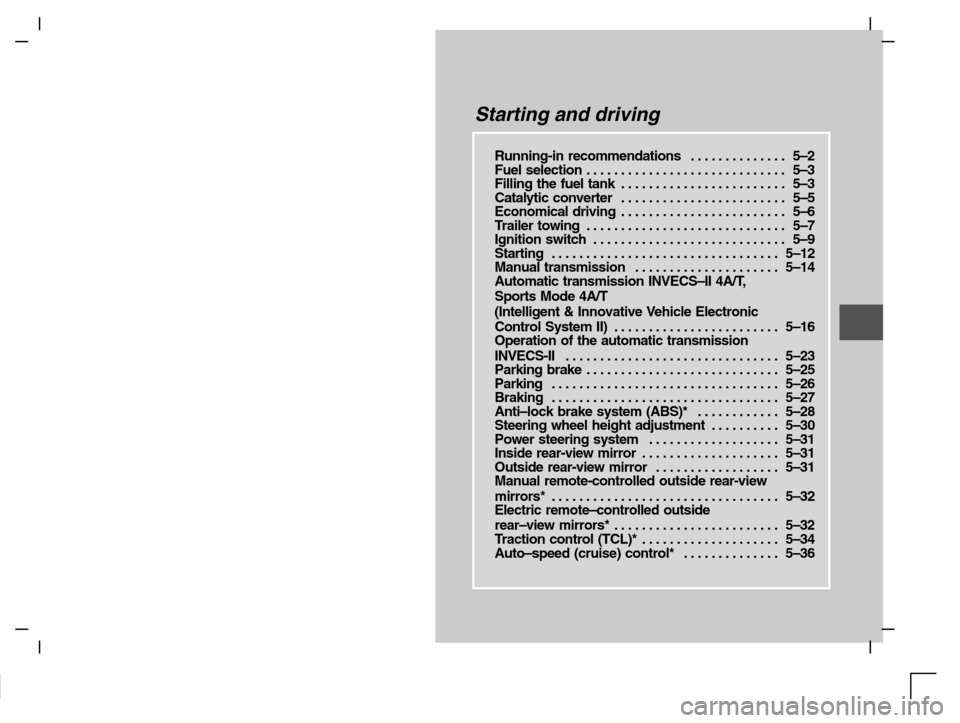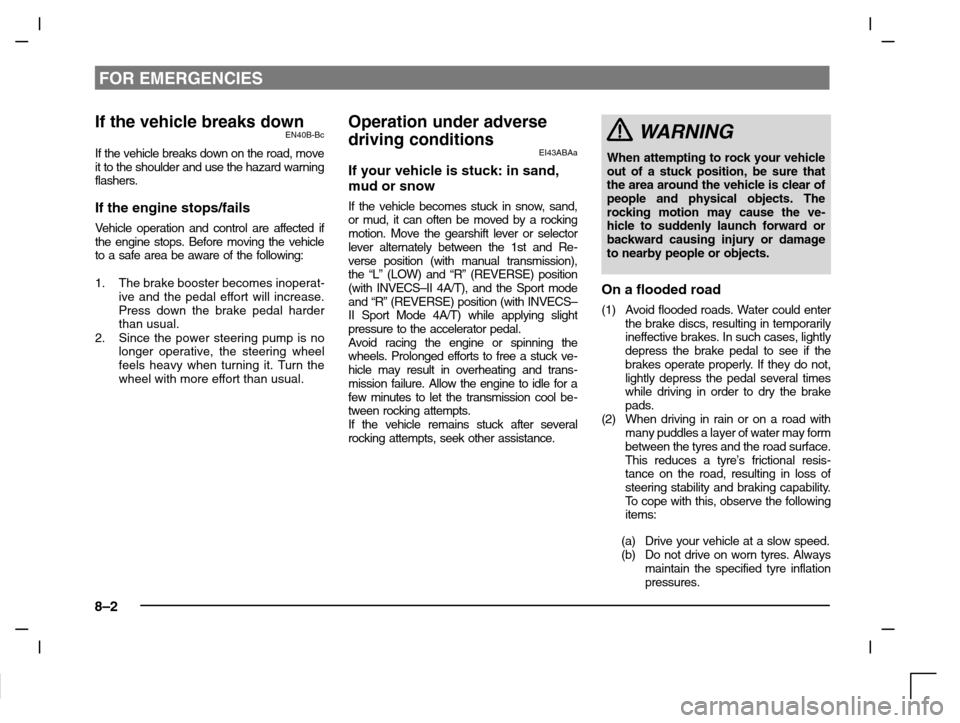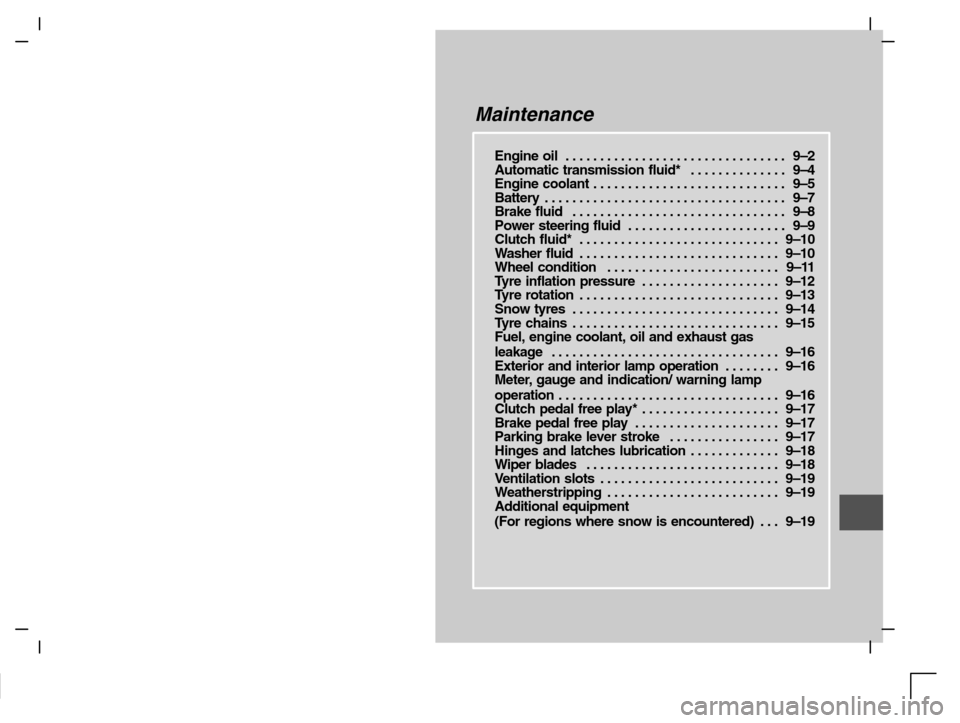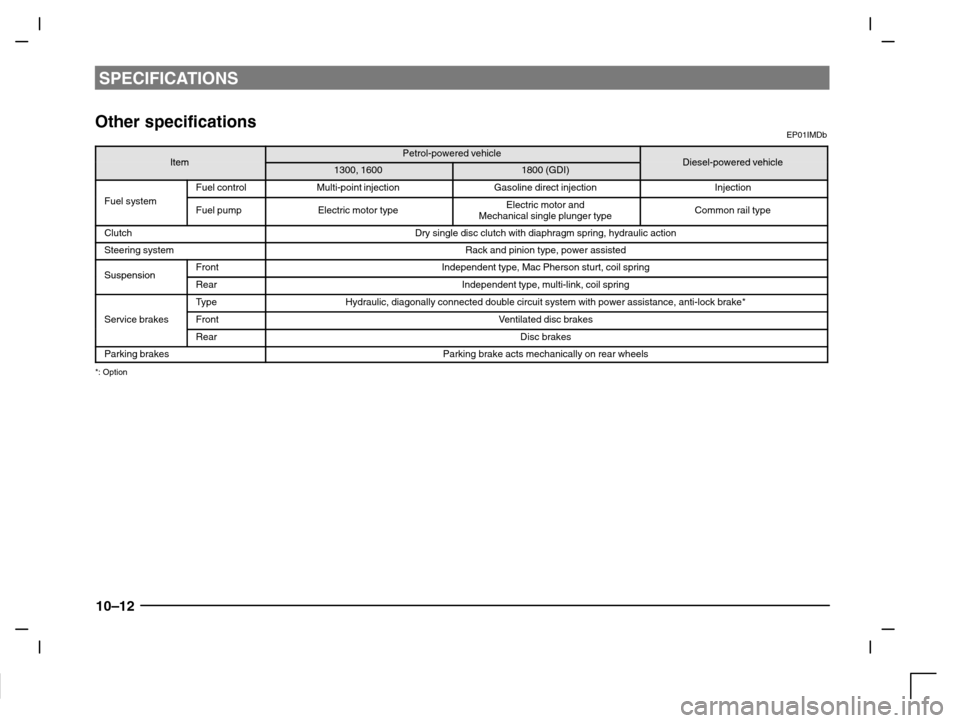2000 MITSUBISHI CARISMA power steering
[x] Cancel search: power steeringPage 101 of 280

Starting and driving
Running-in recommendations 5–2. . . . . . . . . . . . . .
Fuel selection 5–3. . . . . . . . . . . . . . . . . . . . . . . . . . . . .
Filling the fuel tank 5–3. . . . . . . . . . . . . . . . . . . . . . . .
Catalytic converter 5–5. . . . . . . . . . . . . . . . . . . . . . . .
Economical driving 5–6. . . . . . . . . . . . . . . . . . . . . . . .
Tr ailer towing 5–7. . . . . . . . . . . . . . . . . . . . . . . . . . . . .
Ignition switch 5–9. . . . . . . . . . . . . . . . . . . . . . . . . . . .
Starting 5–12. . . . . . . . . . . . . . . . . . . . . . . . . . . . . . . . .
Manual transmission 5–14. . . . . . . . . . . . . . . . . . . . .
Automatic transmission INVECS–II 4A/T,
Sports Mode 4A/T
(Intelligent & Innovative Vehicle Electronic
Control System II) 5–16. . . . . . . . . . . . . . . . . . . . . . . .
Operation of the automatic transmission
INVECS-II 5–23. . . . . . . . . . . . . . . . . . . . . . . . . . . . . . .
Parking brake 5–25. . . . . . . . . . . . . . . . . . . . . . . . . . . .
Parking 5–26. . . . . . . . . . . . . . . . . . . . . . . . . . . . . . . . .
Braking 5–27. . . . . . . . . . . . . . . . . . . . . . . . . . . . . . . . .
Anti–lock brake system (ABS)* 5–28. . . . . . . . . . . .
Steering wheel height adjustment 5–30. . . . . . . . . .
Power steering system 5–31. . . . . . . . . . . . . . . . . . .
Inside rear-view mirror 5–31. . . . . . . . . . . . . . . . . . . .
Outside rear-view mirror 5–31. . . . . . . . . . . . . . . . . .
Manual remote-controlled outside rear-view
mirrors* 5–32. . . . . . . . . . . . . . . . . . . . . . . . . . . . . . . . .
Electric remote–controlled outside
rear–view mirrors* 5–32. . . . . . . . . . . . . . . . . . . . . . . .
Traction control (TCL)* 5–34. . . . . . . . . . . . . . . . . . . .
Auto–speed (cruise) control* 5–36. . . . . . . . . . . . . .
Page 111 of 280

STARTING AND DRIVING
5–11
CAUTION
(1) Do not remove the ignition key
from the ignition switch while
driving. The steering wheel will
lock, causing loss of control.
(2) If the engine is stopped while
driving, the brake servomechan-
ism will cease to function and
braking efficiency will deterio-
rate. Also, the power steering
system will not function and it will
require greater manual effort to
operate the steering.
(3) Do not leave the key in the “ON”
position for a long time when the
engine is not running, doing so
will cause the battery to be dis-
charged.
(4) Do not turn the key to the
“START” position when the en-
gine is running, doing so could
damage the starter motor.
I01B015a
How to lock and unlock the steer-
ing wheel
EI01B-Kb
To lockRemove the key at the “LOCK” position.
Turn the steering wheel until it is locked.
To unlockTurn the key to the “ACC” position while
moving the steering wheel slightly.
CAUTION
Remove the key when leaving the ve-
hicle.
NOTEIf the front wheels are turned, the anti-theft
lock may sometimes make it difficult to turn
the key from “LOCK” to “ACC”. Firmly turn
the steering wheel to the left or to the right as
you turn the key.
Page 131 of 280

STARTING AND DRIVING
5–31
Power steering systemEC13A-Ah
When the engine is stopped, the power
steering system will not function and it will re-
quire greater manual effort to operate the
steering wheel. Keep this in mind in particu-
lar when towing the vehicle. Never turn off
the engine while driving.
Periodically check the power steering fluid
level.
CAUTION
Do not hold the steering wheel in the
fully turned position (either left or
right), for longer than 10 seconds.
This can cause damage to the power
steering pump due to reduced lu-
brication.
I08A027a
Inside rear-view mirrorEI08A-Be
The lever (A) at the bottom of the mirror can
be used to adjust the mirror to reduce the
glare from the headlamps of vehicles behind
you during night driving.
1-Normal
2-Anti-glare
WARNING
Do not attempt to adjust rear-view
mirrors while driving. This can be
dangerous.
Always adjust the mirrors before driv-
ing.
I08B091a
Outside rear-view mirrorEI08A-Za
On the driver’s seat side, a compound
curved-surface mirror is used, while on the
front passenger’s seat side, a single curved-
surface mirror is used.
The compound curved-surface mirror has
different curvatures between the inner and
outer sides of the boundary line (A).
The inner side of the boundary line provides
the same vision as that available from an
ordinary door mirror.
However, the outer side of the boundary line
provides a wider vision than an ordinary door
mirror.
Page 202 of 280

FOR EMERGENCIES
8–2
If the vehicle breaks downEN40B-Bc
If the vehicle breaks down on the road, move
it to the shoulder and use the hazard warning
flashers.
If the engine stops/fails
Vehicle operation and control are affected if
the engine stops. Before moving the vehicle
to a safe area be aware of the following:
1. The brake booster becomes inoperat-
ive and the pedal effort will increase.
Press down the brake pedal harder
than usual.
2. Since the power steering pump is no
longer operative, the steering wheel
feels heavy when turning it. Turn the
wheel with more effort than usual.
Operation under adverse
driving conditions
EI43ABAa
If your vehicle is stuck: in sand,
mud or snow
If the vehicle becomes stuck in snow, sand,
or mud, it can often be moved by a rocking
motion. Move the gearshift lever or selector
lever alternately between the 1st and Re-
verse position (with manual transmission),
the “L” (LOW) and “R” (REVERSE) position
(with INVECS–II 4A/T), and the Sport mode
and “R” (REVERSE) position (with INVECS–
II Sport Mode 4A/T) while applying slight
pressure to the accelerator pedal.
Avoid racing the engine or spinning the
wheels. Prolonged efforts to free a stuck ve-
hicle may result in overheating and trans-
mission failure. Allow the engine to idle for a
few minutes to let the transmission cool be-
tween rocking attempts.
If the vehicle remains stuck after several
rocking attempts, seek other assistance.
WARNING
When attempting to rock your vehicle
out of a stuck position, be sure that
the area around the vehicle is clear of
people and physical objects. The
rocking motion may cause the ve-
hicle to suddenly launch forward or
backward causing injury or damage
to nearby people or objects.
On a flooded road
(1) Avoid flooded roads. Water could enter
the brake discs, resulting in temporarily
ineffective brakes. In such cases, lightly
depress the brake pedal to see if the
brakes operate properly. If they do not,
lightly depress the pedal several times
while driving in order to dry the brake
pads.
(2) When driving in rain or on a road with
many puddles a layer of water may form
between the tyres and the road surface.
This reduces a tyre’s frictional resis-
tance on the road, resulting in loss of
steering stability and braking capability.
To cope with this, observe the following
items:
(a) Drive your vehicle at a slow speed.
(b) Do not drive on worn tyres. Always
maintain the specified tyre inflation
pressures.
Page 213 of 280

FOR EMERGENCIES
8–13
Front
N25A200a
Towing with a rope
1. For vehicles with automatic transmis-
sion check the automatic transmis-
sion fluid level. (Refer to “Automatic
transmission fluid” on page 9–4.)
If the fluid level is low, transport the ve-
hicle with all wheels off the ground.
CAUTION
If the vehicle is out of automatic trans-
mission fluid, the transmission could
be damaged.
2. The towing hooks (A) are located as
shown in the illustrations. Attach the
tow rope to the towing hooks.
Rear
N25A057a
NOTE
(1) Using any part other than the desig-
nated towing hooks (A) could result in
damage to vehicle body.
(2) Use care that the towing rope is kept as
horizontal as possible.
An angled towing rope can damage the
vehicle body.
(3) Never attempt to tow out a ditched ve-
hicle because the towing rope cannot
be kept horizontal.
3. Turn the ignition switch to the “ACC” or
“ON” position to unlock the steering
wheel.
CAUTION
(1) As the engine is not running, the
brake booster and power steer-
ing pump do not operate. This
means higher brake depression
force and higher steering effort
are required. Therefore vehicle
operation is more difficult than
usual.
(2) Do not leave the key in the
“LOCK” position. If the key is re-
moved while driving, the steering
will be locked causing loss of
control.
4. Turn on the hazard warning lamps.
5. Move the gearshift lever (manual
transmission) or the selector lever (au-
tomatic transmission) to Neutral or the
“N” position.
6. During towing make sure that close
contact is maintained between the
drivers of both vehicles, and that the
vehicles travel at low speed. Avoid
abrupt starting or stopping which
might subject the vehicles to shock.
Page 239 of 280

Maintenance
Engine oil 9–2. . . . . . . . . . . . . . . . . . . . . . . . . . . . . . . .
Automatic transmission fluid* 9–4. . . . . . . . . . . . . .
Engine coolant 9–5. . . . . . . . . . . . . . . . . . . . . . . . . . . .
Battery 9–7. . . . . . . . . . . . . . . . . . . . . . . . . . . . . . . . . . .
Brake fluid 9–8. . . . . . . . . . . . . . . . . . . . . . . . . . . . . . .
Power steering fluid 9–9. . . . . . . . . . . . . . . . . . . . . . .
Clutch fluid* 9–10. . . . . . . . . . . . . . . . . . . . . . . . . . . . .
Washer fluid 9–10. . . . . . . . . . . . . . . . . . . . . . . . . . . . .
Wheel condition 9–11. . . . . . . . . . . . . . . . . . . . . . . . .
Tyre inflation pressure 9–12. . . . . . . . . . . . . . . . . . . .
Tyre rotation 9–13. . . . . . . . . . . . . . . . . . . . . . . . . . . . .
Snow tyres 9–14. . . . . . . . . . . . . . . . . . . . . . . . . . . . . .
Tyre chains 9–15. . . . . . . . . . . . . . . . . . . . . . . . . . . . . .
Fuel, engine coolant, oil and exhaust gas
leakage 9–16. . . . . . . . . . . . . . . . . . . . . . . . . . . . . . . . .
Exterior and interior lamp operation 9–16. . . . . . . .
Meter, gauge and indication/ warning lamp
operation 9–16. . . . . . . . . . . . . . . . . . . . . . . . . . . . . . . .
Clutch pedal free play* 9–17. . . . . . . . . . . . . . . . . . . .
Brake pedal free play 9–17. . . . . . . . . . . . . . . . . . . . .
Parking brake lever stroke 9–17. . . . . . . . . . . . . . . .
Hinges and latches lubrication 9–18. . . . . . . . . . . . .
Wiper blades 9–18. . . . . . . . . . . . . . . . . . . . . . . . . . . .
Ventilation slots 9–19. . . . . . . . . . . . . . . . . . . . . . . . . .
Weatherstripping 9–19. . . . . . . . . . . . . . . . . . . . . . . . .
Additional equipment
(For regions where snow is encountered) 9–19. . .
Page 247 of 280

MAINTENANCE
9–9
Use brake fluid conforming to DOT3 or
DOT4. The brake fluid is hygroscopic. Too
much moisture in the brake fluid will adverse-
ly affect the brake system, reducing the
brake performance.
In addition, the brake fluid reservoir is
equipped with a special cap to prevent the
entrance of air, and this cap should not be re-
moved.
The brake fluid level is monitored by a float.
When the brake fluid level falls below the
“MIN” mark, the brake fluid warning lamp
lights up.
WARNING
(1) Take care in handling brake fluid as
it is harmful to the eyes and may
also cause damage to painted sur-
faces. If fluid is spilt, wipe it up as
soon as possible.
(2) Use only the specified brake fluid.
Also, the additives in different
brands may result in a chemical re-
action when mixed together, so
avoid mixing different brands if
possible.
(3)Normally, keep the reservoir tank
cap closed to prevent the brake
fluid from deteriorating.
Petrol-powered vehicles
M09A029a
Power steering fluidEM09A-Oa
Check the fluid level in the reservoir while the
engine is idling.
Unscrew the reservoir cap; the level in this
tank should be kept between the “MAX” and
“MIN” lines.
Use “ATF DEXRON II”.
Diesel-powered vehicles
M09A030a
Page 270 of 280

SPECIFICATIONS
10–12
Other specificationsEP01IMDb
ItemPetrol-powered vehicleDiesel powered vehicleItem1300, 16001800 (GDI)Diesel-powered vehicle
Fuel controlMulti-point injectionGasoline direct injectionInjectionFuel systemFuel pumpElectric motor typeElectric motor and
Mechanical single plunger typeCommon rail type
ClutchDry single disc clutch with diaphragm spring, hydraulic action
Steering systemRack and pinion type, power assisted
SuspensionFrontIndependent type, Mac Pherson sturt, coil springSuspensionRearIndependent type, multi-link, coil spring
TypeHydraulic, diagonally connected double circuit system with power assistance, anti-lock brake*
Service brakesFrontVentilated disc brakes
RearDisc brakes
Parking brakesParking brake acts mechanically on rear wheels
*: Option